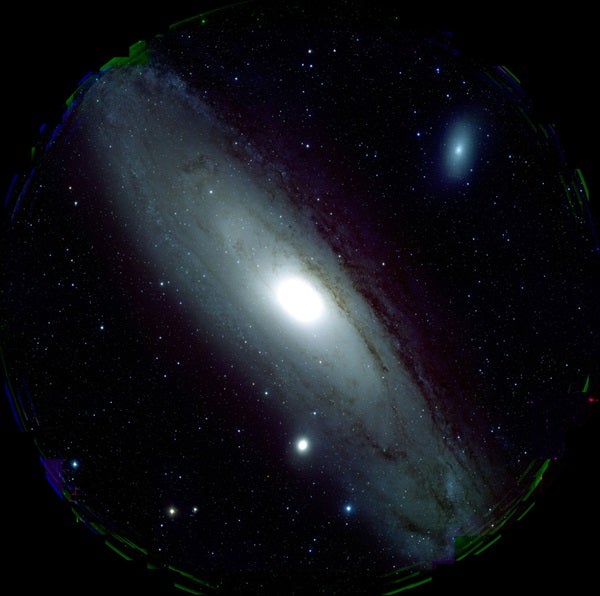HSC’s first beautiful image of M31 gives an answer to the question: Does HSC really deliver what it promises in terms of image quality? It displays a resounding “yes” by demonstrating the sharp detailed resolution of which the camera is capable across the wide field of view that it embraces. The image indicates why this powerful instrument is unique within the domain of current observational technology, enabling high-resolution images from observations with a large primary mirror (8.2 meters [27 feet]) and large field of view (1.5°).
M31, also known as the Andromeda Galaxy, is the spiral galaxy nearest to our Milky Way Galaxy, 2.5 million light-years from Earth. It is one of the brightest objects listed in the Messier catalog and has garnered the attention of observers since A.D. 964 when the Persian astronomer al-Sufi wrote about it. Messier cataloged it as M31 in 1764, 800 years later, and it continues to intrigue the public and astronomers alike. It is visible to the naked eye on moonless nights, even in areas with moderate light pollution. Astronomers find it particularly interesting because it is quite similar to the Milky Way Galaxy and can provide valuable information about how our galaxy formed. Since the galactic center is visible, it is possible to investigate how star formation varies in relation to distance from the center of the galaxy. Of particular significance in HSC’s image is the consistently high quality of resolution of the objects throughout the frame, which surpasses the clear resolution of the image of the Andromeda Galaxy captured by the Subaru Prime Focus Camera (Suprime-Cam) in 2001. Although HSC’s field of view is seven times larger than that of its predecessor, Suprime-Cam, there is no degradation of the image at the edges.
“This first image from HSC is truly exciting,” said Masahiro Takada from the Kavli Institute for the Physics and Mathematics of the Universe (IPMU) in Japan. “We can now start the long-awaited, largest-ever galaxy survey for understanding the evolutionary history and fate of the expanding universe. A ‘cosmic census’ — a large-scale imaging survey of every galaxy over a wide solid angle in the sky and in sufficient depth to probe the distant universe — will include the detailed measurement of hundreds of millions of galaxy shapes and assessment of the effects of gravitational lensing. Such data will allow scientists to map the distribution of dark matter, constrain the nature of dark energy, and search for baby galaxies that were just born in the early universe.”
“HSC is a tremendously exciting project,” said Hitoshi Myrayama from Kavli IPMU. “We at Kavli IPMU have been involved in the project to our full extent. We contributed about a half of the project cost and put more than 20 people working on it. We are also developing and building a multi-object spectrograph called PFS to follow up on the HSC imaging data to determine the distance, motion, and chemical composition of galaxies. The combination of HSC and PFS would allow us to conduct an unprecedented ‘cosmic census.’ We are very much looking forward to the coming survey data!”
“The sharp resolution in the current image augurs the instrument’s capabilities for capturing weak lensing, which is central to HSC’s scientific goals of surveying the parameters and properties of dark matter and dark energy in the universe as well as exploring the causes of the accelerating expansion of the universe,” said Satoshi Miyazaki, director of the HSC project. “In essence, this means an expansion of applications that derive from the instrument’s capacity to make nearly invisible distant faint objects visible and for bringing dark energy and dark matter into the arena of scientific identification and investigation. The design of HSC facilitates this task with faster survey speed and tenfold expansion of file size, while maintaining quality equivalent to Suprime Cam’s.”
Scientists have long dreamed of being able to image billions of galaxies across the sky. As HSC proceeds along a successful path of testing and demonstrates its capabilities, that dream is becoming a reality.










